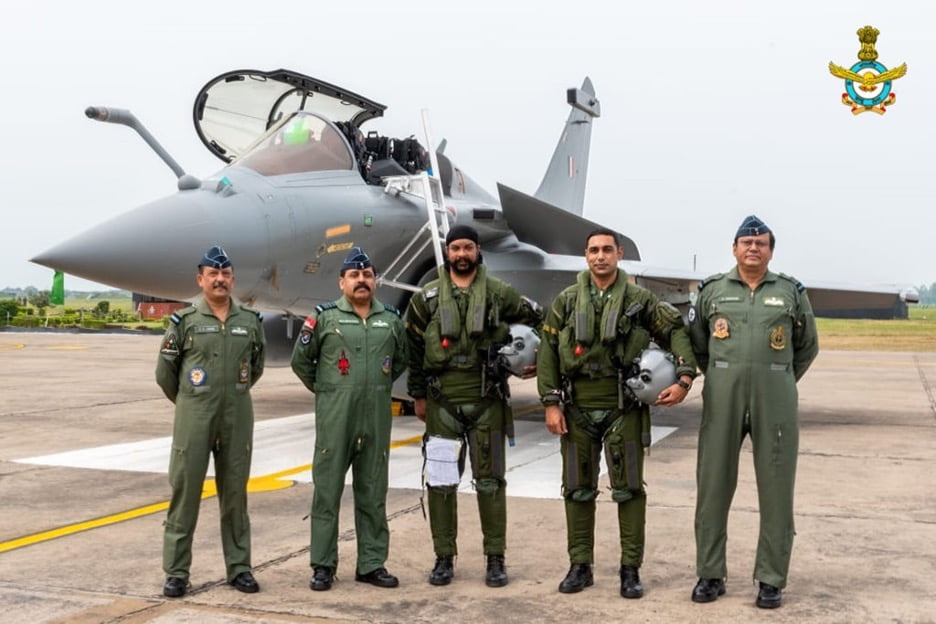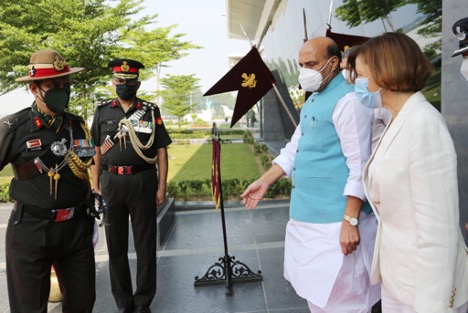By Gulshan Luthra
New Delhi. The Indian Air Force ceremonially inducted its first five Rafale Medium Multi Role Combat Aircraft (MMRCA) September 10 with Defence Minister Rajnath Singh handing over the commissioning plaque to the Commanding Officer of the Number 17 Golden Arrows, Gp Capt Harkirat Singh.
It was a proud moment for India, said Rajnath Singh, and his French counterpart, Florence Parly who had flown in as the Chief Guest for the occasion, shared the sentiment as an example of Indo-French strategic cooperation, pointing out that France will always be on India’s side. Top representatives of Dassault Aviation, which makes the Rafale, and its partner companies Safran (Engines), Thales (EW Systems) and MBDA (Missiles), were in her delegation.
“It’s a game-changer and a lesson to our neighbours for the situation they have created on the borders,” Rajnath Singh, speaking in Hindi, declared while terming the induction of the first five of the 36 Rafale fighters that India has purchased from France as a “historic occasion and a matter of pride” for the country.
Chief of the Air Staff Air Chief Marshal R.K.S. Bhadauria, the host for the event, said the aircraft have been operational ever since their landing at the frontline Ambala Air Force Station on July 29, and that the induction of Rafales could not have come at a more appropriate time, given the scenario on the borders with tension along both the LAC (Line of Actual Control) with China in Ladakh and on the Line of Control (LOC) with Pakistan in the West.
“Rafale is good to go, and deliver,” he observed.
IAF has been giving full training to the Rafale pilots in France itself, and they have been conducting sorties all along the northern and western borders after arriving at Ambala, pairing up with other aircraft like the Su 30 MKIs, Jaguars and others. Rafale is the most modern combat jet in the IAF inventory, with weapons of matching lethality, and Air Chief Bhadauria disclosed that all the pilots and aircraft had been engaged in live, “intensive and integrated training” that includes “firing of advanced weapons”.
Chief of Defence Staff General Bipin Rawat, former Chief of Air Staff B.S. Dhanoa, and top IAF officials graced the occasion.
India is buying 36 Rafales from France in a Government-to-Government deal, and all the aircraft are due for delivery by end-2021.
The two ministers held delegation level talks to review the progress of the Rafale deal, as also the possibility of more aircraft from Dassault, more submarines and vessels from Naval Group, and some advanced weapons from MBDA, and Electronic Warfare systems from Thales. Safran already has a presence at HAL, helping its aircraft and helicopter designs and capabilities.
Ms Parly, obviously looking happy, flew from New Delhi to Ambala in the Indian Defence Minister’s Embraer executive jet, and spoke very warmly in English, and praised the professionalism of IAF officers. Normally, the French speak in their language at formal events.
She was the accorded the welcome Guard of Honour at IAF’s Palam airbase in New Delhi on arrival. In a Tweet, she said: “Together, we are writing a new chapter of Indo-French defence ties. Behind the Rafale, there is above all a friendship. A commonality of interests, of vision, of values in the region.”
The acquisition of the fully combat-proven jets would not only give India an edge in the region but will also be able to strengthen its industrial base and upgrade its technological skills, said Parley, who is on her third official visit to India since 2017.
French Ambassador in New Delhi Emmanuel Lenain, who accompanied her, said the two countries had “in-depth talks” covering Transfer of Technology (ToT) for various Make in India projects on industrial scale, operational defence cooperation, Indo-Pacific Maritime Security, Joint Drill Modalities in a pandemic, anti-terror action, and major regional and international strategic issues.
The induction ceremony, on a sunny morning, was marked by a scintillating aerial display, a water-cannon salute, a multi-religious prayer and forceful reaffirmations of the depth of India-France strategic cooperation.
Ambala, not far from China or Pakistan, is IAF’s oldest airbase, commissioned in 1919 by the Royal Air Force. It has the privilege now of hosting IAF’s newest combat aircraft, the high-technology Rafale.
The airbase is considered a first responder to any threat on the country’s Western and Northern borders, being around 300 km or 10 minutes in either direction.
A second Rafale Squadron will be located at Hashimara airbase, in Eastern India.
Aircraft from France have been operating from the Ambala airbase since 1955, and virtually every senior officer and Air Marshal of the Indian Air Force has served there, flying one or the other aircraft from IAF’s inventory. The French Mystere, the Anglo-French Jaguar, the Soviet Union’s MiG-21 and MiG-29 have all operated from this vital airbase.
Rafale is described by Dassault as an omni-role aircraft, capable of swing roles from Air-to-Air or Air-to-Ground strikes in a single mission. The Rafale is also capable of nuclear strikes and shipboard missions from aircraft carriers.
The ceremony began with the unveiling of the Rafale amidst flashing strobe lights followed by multi-faith prayers and a flypast by three Rafales, a Sukhoi Su-30 and a Jaguar in the “Golden Arrow” formation of the 17 Squadron of the IAF.
The 17 Squadron had participated in the 1999 Kargil conflict under the command of the then Wing Commander B.S. Dhanoa, later the Air Chief. One of the Rafale is designated after him as BS 001.
A highlight of the induction ceremony was the breathtaking display by three Rafales performing heart-stopping manoeuvres like the high-speed Mach Rate Turn, a Minimum Radius Turn in an area smaller than a hockey field, an Inverted Flight and a Vertical Charlie that demonstrated the extreme versatility of the aircraft and its ability to switch to multifarious tasks in a matter of moments.
The indigenous Tejas light combat aircraft (LCA), built on French designs but with a US GE 404 engine, then demonstrated that it could also rise to the occasion although it is a Light Combat Aircraft (LCA), smaller than its bigger brother, the Medium Multi Role Combat Aircraft (MMRCA) Rafale.
The IAF’s modernisation plans have been delayed ever since Prime Minister V.P. Singh flattened the acquisition process in the late 1980s to zero, alleging corruption in every deal.
The IAF had initiated an exercise for acquiring 126 MMRCAs in 2007, selected the Rafale from among six contenders, but no deal could be made as somehow, a clause came up that while HAL would be responsible for integrating and manufacturing 70 per cent of the aircraft at its facilities in India, the responsibility for the quality of production at HAL would be that of the French supplier.
Dassault refused, saying: You make it, you are responsible.
Later, in 2015, Prime Minister Modi’s government rightly cancelled that stalled process, and as IAF was rapidly falling short of aircraft, decided to acquire 36 Rafales, or Two Squadrons of 18 each, under a G-to-G deal. It is this deal which is fructifying now.
IAF has meanwhile a second tender now in place, for 114 MMRCAs, single or twin engine, as in the first tender in 2007. Actually, IAF needs a combination of 400 aircraft, in a rough ratio of 70:30 for single and twin engines.
Except for the Su 30 MKI, which came in the 1990s, all IAF aircraft are of 1980s vintage, although upgraded. Rafale is the most modern, and contemporary aircraft now in IAF’s inventory.
Defence Secretary Dr Ajay Kumar, Secretary Department of Defence R&D and Chairman DRDO Dr G Satheesh Reddy along with other senior officers of Ministry of Defence witnessed the milestone event.
Air General Eric Autellet, Vice Chief of the Air Staff of the French Air Force, Mr Eric Trappier Dassault Aviation Chairman and Chief Executive Eric Trappier, MBDA CEO Eric Beranger were part of the large French delegation.
India is the fourth country after France, Egypt and Qatar to have inducted the Rafale, a 4.5 generation combat aircraft.
This article was published by India Strategic on September 10, 2020.









